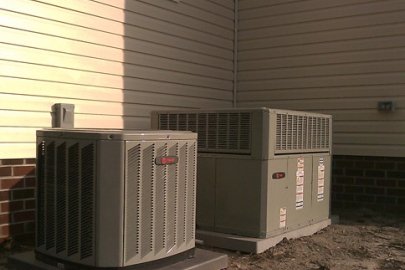Ductless minisplit heat pumps (also called “minisplits”) are an excellent option for retrofitting houses with non-ducted heating systems like hydronic (hot water heat), radiant panels, and space heaters (wood, kerosene, propane). They are also ideal for room additions where extending or installing distribution ductwork is not feasible and for very efficient new homes that require only a small space conditioning system. For maximum energy savings, choose an ENERGY STAR® certified unit and hire an experienced installer.
How Ductless Minisplit Heat Pumps Work
Like standard air-source heat pumps, minisplits have two main components: an outdoor compressor/condenser and an indoor air-handling unit. These components are linked by a conduit that houses the power cable, refrigerant tubing, suction tubing, and a condensate drain.
Advantages of Ductless Minisplit Heat Pumps
- Small Size and Flexibility: Minisplits are compact and offer flexibility for zoning or heating and cooling individual rooms. Many models support up to four indoor air-handling units connected to one outdoor unit, allowing conditioning for four separate zones or rooms. Each zone has its own thermostat, providing flexibility to condition only occupied spaces, saving energy and money.
- Ease of Installation: Installing minisplits is simpler than many other space conditioning systems. The connection between the outdoor and indoor units generally requires only a three-inch hole through a wall for the conduit. The outdoor unit can be located up to 50 feet away from the indoor evaporator, allowing for placement in a less visible or more advantageous location.
- Energy Efficiency: Minisplits have no ducts, avoiding the energy losses associated with the ductwork of central forced air systems. Duct losses can account for more than 30% of energy consumption for space conditioning, especially if ducts are in an unconditioned space like an attic. Ducted heat pumps typically achieve efficiency ratings between 15.2 to 25 SEER2, while ductless minisplits can achieve ratings between 15.2 and 35 SEER2.
- Interior Design Flexibility: Minisplits offer more interior design options. Indoor air handlers can be suspended from the ceiling, mounted flush into a drop ceiling, or hung on a wall. Floor-standing models are also available. Most indoor units are about seven inches deep and have sleek, high-tech-looking jackets. Many units also come with a remote control for easy operation.
Disadvantages of Ductless Minisplit Heat Pumps
- Higher Installation Costs: Installing minisplits can be more expensive than some other systems, though lower operating costs and available rebates or financial incentives can help offset the initial expense. Explore incentives in your area using the ENERGY STAR Home Improvement Savings tool.
- Sizing and Placement Challenges: Proper sizing and location of each indoor unit are crucial. Oversized or incorrectly placed air handlers can result in short cycling, wasting energy and failing to provide proper temperature or humidity control. An oversized system is more expensive to buy and operate.
- Aesthetic Concerns: Some people may not like the appearance of the indoor units. While less obtrusive than window room air conditioners, these units do not have the built-in look of central systems. Additionally, there must be a place to drain condensate water outdoors.
Take Action
Ensure your system is installed correctly and maintained regularly to maximize efficiency and savings. If you are considering a ductless minisplit heat pump for your home, consult with a qualified HVAC professional to determine the best system for your needs. For more information on energy-efficient heating and cooling solutions, visit the ENERGY STAR® website.
Learn More About Heat Pumps
Subscribe to receive updates and energy-saving tips for consumers and homeowners.





